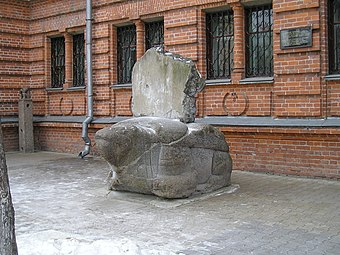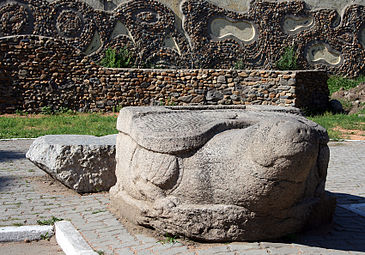|
Bixi
Bixi, or Bi Xi (Wade–Giles: Pi-hsi), is a figure from Chinese mythology. One of the nine sons of the Dragon King,[citation needed] he is depicted as a dragon with the shell of a turtle. Stone sculptures of Bixi have been used in Chinese culture for centuries as a decorative plinth for commemorative steles and tablets,[1] particularly in the funerary complexes of its later emperors and to commemorate important events, such as an imperial visit or the anniversary of a World War II victory. They are also used at the bases of bridges and archways.[2] Sculptures of Bixi are traditionally rubbed for good luck, which can cause conservation issues.[3] They can be found throughout East Asia and the Russian Far East. History  The tradition of tortoise-mounted stelae originated no later than early 3rd century (late Han dynasty). According to the 1957 survey by Chêng Tê-k'un (鄭徳坤), the earliest extant tortoise-borne stele is thought to be the one at the tomb of Fan Min (樊敏), in Lushan County, Ya'an, Sichuan.[4] Victor Segalen had earlier identified the stele as a Han dynasty monument. Present-day authors agree, usually giving it the date of 205 AD.[5][6][7] The stele has a rounded top with a dragon design in low relief - a precursor to the "two intertwined dragons" design that was very common on such steles even in the Ming and Qing Dynasties, over a thousand years later.[4][8] In the collection of the Nanjing Museum there is a hunping funerary jar, dating to 272 AD, with a miniature architectural composition on top, depicting, among other objects, a tortoise carrying a stele erected by the Jin dynasty governor of Changsha in honor of a local dignitary.[9] Perhaps the best known extant early example of the genre is the set of four stele-bearing tortoises at the mausoleum of Xiao Xiu (475-518), who was the younger brother of the first Liang dynasty emperor Wu (Xiao Yan), near Nanjing.[10][11][12] The bixi tradition flourished during the Ming and Qing dynasties. The Ming founder, the Hongwu Emperor, in the first year after the dynasty had been proclaimed (1368), adopted regulations, allowing tortoise-based funerary tablets to the higher ranks of the nobility and the mandarinate. He tightened the rules in 1396, leaving only the highest nobility (those of the gong and hou ranks) and the officials of the top 3 ranks eligible for bixi-based stelae. The type of dragons crowning the tortoise-born stele, and the type and number of other statuary at the tomb site, were prescribed by the same regulations as well.[13]  At the Hongwu Emperor's own mausoleum, a huge bixi holding the so-called Shengde stele welcomes visitors at the Sifangcheng pavilion at the entrance of the mausoleum complex. Three centuries later (1699), the Kangxi Emperor of the Qing dynasty visited Nanjing and contributed another tortoise, with a stele praising the founder of the Ming, comparing him to the founders of the great Tang and Song dynasties of the past.[14][15] The Hongwu Emperor's tortoise tradition was continued by the later Ming and Qing emperors, whose mausoleums are usually decorated by bixi-born steles as well. Even the self-declared emperor Yuan Shikai was posthumously honored with a bixi-based stele in Anyang,[16] as was the Republic of China Premier Tan Yankai (1880–1930), whose stele near Nanjing's Linggu Temple had its inscription erased after the Communist Revolution. Occasionally, a foreign head of state was honored with a bixi as well, as it happened to the sultan of Brunei Abdul Majid Hassan, who died during his visit to China in 1408. The sultan's grave, with a suitably royal bixi-based monument, was discovered in Yuhuatai District south of Nanjing in 1958.[17] After an ancient Christian stele was unearthed in Xi'an in 1625, it, too, was put on the back of a tortoise. In 1907, this so-called Xi'an Stele was moved to the Stele Forest Museum along with its tortoise.[18][19] These days, long-lost bixi continue to be unearthed during archaeological excavations and construction work. Among the most remarkable finds is the discovery of a huge 1200-year-old one in Zhengding (Hebei Province) in June 2006. The stone turtle is 8.4 m long, 3.2 m wide, and 2.6 m tall, and weighs 107 tons. It has since been moved to Zhengding's Kaiyuan Temple.[20] Outside China  The concept of a tortoise-borne, dragon-crowned stele was adopted early by China's northern neighbors. The earliest extant monument of the Turkic Kaganate - the so-called "Bugut Stele" of the late 6th century from Arkhangai Province in western Mongolia with a Sogdian and (most likely) Brahmi Mongolic inscription was installed on a stone tortoise. It is now in the provincial capital, Tsetserleg.[22][23] According to the Turkish researcher Cengiz Alyilmaz, it was the design of this stele that influenced the builders of the important 8th-century stelae with Old Turkic inscriptions, many of which also stood on tortoises.[23][24] Among them, the most accessible one is probably Bayanchur Khan's (Eletmish Bilge Kağan)'s Terhin-Gol stele (753 AD), now in the Mongolian Academy of Sciences in Ulan Bator.[25] Later, the Jurchen Jin dynasty (1115-1234) and the Mongol Yuan dynasty erected tortoise-based monuments as well, some of which have been preserved in Russia's Ussuriysk and Mongolia's Karakorum. In Japan, this form of tortoise-supported stele is found primarily at the graves of prominent Kamakura period (1185–1333) figures, especially in the city of Kamakura. Another large collection of tortoise-borne stelae, spanning the 17th through 19th centuries, can be seen at the cemetery of the Tottori Domain daimyō outside Tottori. Otherwise, the form does not seem to have been particularly popular in earlier or later times. In Korea, tortoise-borne stelae are known during the Three Kingdoms of Korea period (e.g., the Tombstone of King Muyeol of Silla, erected 661).[26] Monuments of this type have been preserved from the later Goryeo dynasty as well, such as the Stele of Bongseon Honggyeongsa (1026).[27] Vietnam also has a long tradition of tortoise-born stelae, where they commemorate Emperor Lê Thái Tổ as well as the graduates of the Confucian academy at Hanoi's Temple of Literature. While there is no indigenous tradition of erecting stelae on tortoise-shaped pedestals in the United States, a Qing period bixi can be seen on the campus of Harvard University in Cambridge, Massachusetts. This bixi was given as a gift to Harvard in 1936 by the members of Harvard Clubs in China; an appropriate text was carved for the occasion on the tablet carried by the tortoise.  Development as an art formAccording to Victor Segalen's assessment, the early (Han and the Six Dynasties) stone tortoises were artistic images of quite real aquatic turtles.[5] The creatures looked quite realistic through the Song dynasty, when huge tortoise pedestals, such as the ones in Shou Qiu near Qufu, or the one in Dai Miao at Mount Tai, were erected. The early-Ming specimens, while still definitely chelonian, had sprouted small ears; the sides of their heads and their carapaces are often decorated by a leaf-like design. They usually have prominent teeth, which real-life turtles don't.[28] By the mid-Qing (the 18th century), however, the stele-bearing tortoise becomes the characteristic dragon-headed bixi.
According to some 19th-century western authors, the Chinese tradition of using a tortoise as a pedestal may have a common source with the Indian legend of the world being held up by a giant turtle.[29] NameThe word bi 贔 or bixi 贔屭 (also written with a variant character, 贔屓) is translated by Chinese dictionaries as "strong", "capable to support great weight". The word bixi is attested already in Zhang Heng's (78-139) "Western Metropolis Rhapsody" (Xi Jing Fu), which mentions "the great strides" of the giant divine bixi.[30] Zhang Heng's follower, Zuo Si (250 - 305), in his Wu Capital Rhapsody (Wu Jing Fu), explicitly associates the attribute bixi with the legendary giant turtle ao, whose head supports a sacred mountain.[31] The term bixi became associated with the stele-carrying tortoises no later than the Ming dynasty. The terminology, however, did not immediately become stable. The earliest known Ming-era list of fantastic creatures appearing in architecture and applied art is given by Lu Rong (1436–1494) in his Miscellaneous records from the bean garden (菽園雜記, Shuyuan zaji). The bixi, with the syllables swapped (屭贔, xibi), appears in the first position in that list:
Lu Rong claims that his list (including the total of 14 creatures) is based on the ancient books of beasts and supernatural creatures, the Shan Hai Jing and the Bo Wu Zhi (博物志); however, as the modern researchers Yang Jingrong and Liu Zhixiong note, that is not the case, and the names, much more likely, were taken by Lu Rong from the folklore of his time.[33] Soon after Lu Rong, the mighty tablet-carrying tortoise appears in various lists of the "Nine children of the Dragons", compiled by several Ming authors. However, both Li Dongyang (1441–1516), in his Huai Lu Tang Ji, and Xie Zhaozhe (謝肇淛, 1567–1624), in his Wu Za Zu (五雜俎, Five Assorted Offerings, ca. 1592), refer to the tortoise that carries the stele by the name baxia (霸下), rather than bixi; at the same time they apply the name bixi to the "literature-loving" dragons that appear on the sides of the stele:
The name bixi, however, is given to the table-carrying tortoise in the more popular version of the list of the "Nine Children of the Dragon". In this form of the list, given e.g. by Yang Shen (1488–1559), the bixi is given the first position:
Stone tortoises in art and popular loreIt is said that an old legend of the stone tortoise made by Lu Ban that went to swim in the ocean every summer, and came back to its seaside hill in the fall, inspired Lu Ji's lines: [36] [37]
The opening chapter of the 14th-century novel Water Margin involves Marshal Hong releasing 108 spirits imprisoned under an ancient stele-bearing tortoise. [38] A bixi plays a key role in a ghost story, "The Spirit of the Stone Tortoise" (贔屭精, Bixi jing), from Yuan Mei's (1716–1797) collection What the Master does not Speak of.[39] The French poet and researcher Victor Segalen (1878–1919), who published both a scholarly book about China's stelae[40] and a book of poetry-in-prose about them,[41] was also impressed by the "truly emblematic" stone tortoises, their "firm gestures and elegiac posture".[42] Today, the image of the bixi continues to inspire modern Chinese artists.[43] Preservation concernsAs with other stone (particularly, marble and limestone) statuary, bixi turtles and their stelae are vulnerable to acid rain (or, in winter, acid snow). On the Harvard University campus, the curators of its turtle protect it against "acid snow" by wrapping it with a waterproof cover for the winter.[44] A more bixi-specific concern is the wear to the creatures' noses from the people who touch them for good luck. At Hanoi's Temple of Literature, highly popular with visitors, this has become a sufficient concern to the site's managers as to make them develop plans for introducing creative landscaping and structural obstacles to keep visitors from touching the temple's 82 stone turtles.[28][45] NotesWikimedia Commons has media related to Bixi.
See also
References
External links
|
||||||||||||||||||||||||||||||||||||||||||||||||||||||||||||||||||||||||||||
















